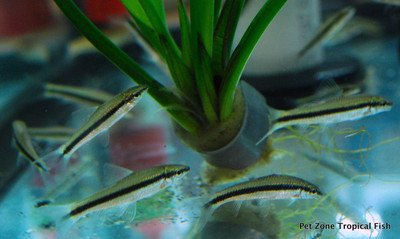Unveiling the Siamese Algae Eater: Your Ally in Aquatic Algae Control
Posted by Max Gandara on on 2nd Apr 2024
Appearance and Identification
The Siamese Algae Eater is easily identifiable by its sleek, elongated body, streamlined fins, and distinctive coloration. It features a silver or metallic body adorned with a prominent black stripe that extends horizontally from its snout to the base of its tail. This characteristic stripe sets it apart from other algae-eating species and makes it a striking addition to freshwater aquariums.
In addition to its striking appearance, the Siamese Algae Eater boasts a slender, torpedo-shaped body and a slightly downturned mouth adapted for scraping algae off surfaces. Adult specimens typically reach lengths of around 4 to 6 inches (10 to 15 centimeters), although some individuals may grow slightly larger under optimal conditions.
Natural Habitat
Native to Southeast Asia, particularly Thailand, Malaysia, and Indonesia, the Siamese Algae Eater inhabits rivers, streams, and tributaries with moderate to fast-flowing water. In its natural habitat, it can be found among submerged vegetation, rocky outcrops, and driftwood, where it forages for algae and small invertebrates.
Water parameters in the native range of the Siamese Algae Eater typically include temperatures between 72°F to 79°F (22°C to 26°C), pH levels around 6.5 to 7.5, and moderate hardness. Aquarists seeking to replicate their natural environment should aim for similar conditions in their aquariums, along with ample hiding places and water movement.
Aquarium Care
Keeping Siamese Algae Eaters in captivity is relatively straightforward, provided their basic care requirements are met. Here are some essential care guidelines:
- Tank Size: Provide a spacious aquarium with ample swimming space and hiding places. A minimum tank size of 20 gallons is recommended for a small group of Siamese Algae Eaters, although larger tanks are preferred for larger groups or community setups.
- Water Parameters: Maintain stable water conditions with temperatures between 72°F to 79°F (22°C to 26°C), pH levels between 6.5 to 7.5, and moderate hardness. Regular water changes and proper filtration are essential for maintaining water quality and oxygenation.
- Substrate and Decor: Use a fine substrate such as sand or smooth gravel to prevent injury to the fish's delicate barbels. Decorate the aquarium with driftwood, rocks, and live plants to create a naturalistic environment and provide hiding places. Avoid sharp decorations or abrasive substrates that could injure the fish.
- Diet: While Siamese Algae Eaters are primarily algae eaters, they also require a balanced diet consisting of high-quality sinking pellets, flakes, and occasional treats such as frozen or live foods like bloodworms, brine shrimp, and vegetable matter. Feed them small portions multiple times a day to ensure optimal nutrition and algae control.
- Compatibility: Siamese Algae Eaters are generally peaceful and can be kept with a variety of tankmates, including other similarly sized and temperamented species such as tetras, rasboras, danios, and peaceful cichlids. Avoid housing them with aggressive or fin-nipping species that may harass or injure them.
Algae Control
One of the primary reasons for keeping Siamese Algae Eaters in aquariums is their exceptional ability to control algae growth. These voracious grazers will eagerly consume various types of algae, including green algae, diatoms, and filamentous algae, helping to keep aquarium surfaces clean and free of unsightly algae blooms.
However, it's essential to note that Siamese Algae Eaters may become less efficient algae eaters as they mature, preferring supplemental foods over algae. Therefore, it's crucial to provide a balanced diet and monitor algae growth regularly to ensure that their dietary needs are met and algae proliferation is kept in check.
Conclusion
In the dynamic world of freshwater aquaria, the Siamese Algae Eater stands as a valuable ally in the ongoing battle against algae proliferation. With its striking appearance, peaceful demeanor, and exceptional algae-eating capabilities, this species continues to earn the admiration and appreciation of aquarists seeking to maintain clean, healthy aquarium environments. By providing proper care, attention, and appreciation for these invaluable algae controllers, enthusiasts can experience the beauty and functionality of the Siamese Algae Eater in their own aquatic realms.

